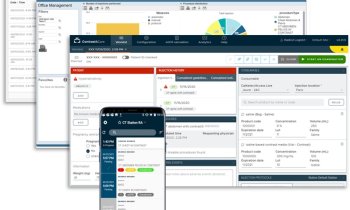E-prescribing in the US
Dot M McSherry, of i.t. Communications, reports
on the potential for huge savings in the US economy
President Barack Obama has made e-prescribing an element of his plan to improve the US healthcare system
In the US, brand name prescription drugs are expensive costs for commercial health insurance companies and the individuals they insure. When prescription drug coverage is included in a health insurance policy, the insured person is usually required to make a payment for a portion of the cost of the drug. As a financial incentive to stimulate the purchase of lower-cost prescription drugs, ‘co-payments’ are tiered, with the lowest co-payment charged for generic drugs. However, when a patient is given a prescription for a brand name drug, it is the individual’s choice if he wishes to substitute the generic drug instead. And the patient had no option whatsoever to replace the brand name drug with a comparable, but different and potentially less costly, drug, which a pharmacist may recommend.
Electronic prescription systems automatically alert physicians to less costly drugs and different drug alternatives when a specific drug is ordered. Since these systems were first introduced, there have been many anecdotal reports that, by making busy physicians aware of the selection of drug choices for the medication they are prescribing, more physicians will select a low-cost option.
The first large scale economic analysis of the use of an electronic prescription system made headline news throughout the US. The analysis, published in the Archives of Internal Medicine in December 2008, determined that with only 20% utilisation, for every 100,000 people with ‘average’ prescription use, expenses could be reduced by $845,000 per year. This equates to $12, 675, 000 for the study group of 1.5 million people. With 50% utilisation by doctors, the cost savings could potentially equal $2,112,500 for every 100,000 people or $31, 687,500.
The study was conducted by researchers at Brigham and Women’s Hospital and the Institute for Health Policy in Boston. They analysed prescription drug purchases of 1.5 million people who had health insurance cover that included three-tier co-payment prescription drug cover and filled 17.4 million prescriptions over an 18-month period. Data was analysed for a six-month period before an electronic prescription system called the eRx Collaborative began operations in the State of Massachusetts and for its first full year of operations. The analysis included all individuals who filled at least one prescription between 1 October 2003 to 31 March 2005, who were enrolled in health programmes of just two large health insurance companies, Blue Cross Blue Shield of Massachusetts and the Tufts Health Plan.
The researchers developed sophisticated statistical models to analyse the cost of prescription drugs of 1,466,564 patients whose physicians did not participate in the eRxCollaborative and the 64,749 patients whose physicians did. In its first year of operation, only 1,198 physicians out of 35,651 who qualified utilised the system.
The early adopters were predominantly internal medicine, paediatric and family practice physicians with community-based medical practices. The eRx Collaborative had identified physicians who wrote a high volume of prescriptions, and they were offered a wireless mobile device with electronic prescription software and all necessary secure communications services, free of charge for the entire first year. The largest group of physicians who qualified, but declined to participate, were medical specialists (55% of the total).
The researchers determined that the physicians using an electronic prescription system increased the percentage of generic drugs or lower cost drug alternatives (Category 1) by 6.6%. They did this when using the system for only 20% of the total number of prescriptions they wrote. Use of the system was entirely voluntary. But when they did use it, they selected ‘Category 1’ drugs 61.4% of the time. By comparison, the physicians who qualified to use the system but chose not to adopt wrote prescriptions for 2.6% more ‘Category 1’ drugs. They selected ‘Category 1’ drugs for 53.2% of the time.
While the cost savings estimates that made headlines were just estimates, they reveal the huge potential to reduce US healthcare costs if electronic prescription systems were utilised more by doctors. The two key inhibitors are customary habit and cost. The US Department of Health and Human Services estimated in 2007 that the first year costs of implementing an electronic prescription system would be $3,000 per physician. Since physicians themselves do not benefit, the question is who would pay this expense.
The State of Massachusetts leads the nation in terms of use of electronic prescription systems in 2006 and 2007, receiving the Safe-Rx Award from the leading US pharmaceutical associations. The eRx Collaborative, which now includes a larger group of health insurance companies, reported that in 2007, nearly five million prescriptions were prescribed electronically, an increase of 8.4% from 2006. 471 new physicians joined the system, exceeding the eRx Collaborative’s goal for 2007 of 385 new participants. The total number of physicians currently using the system is 5,600.
Blue Cross Blue Shield of Massachusetts, one of the insurance company members, reported that its members whose doctors used electronic prescription systems in 2007, saved 5% in drug co-payment costs. This represented an $800,000 reduction for a very small portion of its 3,000,000 members. It also reported that an independent study determined that the electronic prescription system prevented 724 potential adverse drug events in 2007, with a potential cost of $630,000 to the insurance company.
A team of researchers at the Institute for Health Policy are in the midst of a study investigating the impact of office-based electronic prescribing on clinical outcomes of patients.
US government legislates incentives for use
The Centre for Improving Medication Management issued a report in June 2008 stating that more than 35,000,000 prescriptions were ordered electronically in 2007 by approximately 70,000 doctors. This represented only 2% of the total number of prescriptions that could have been written electronically. US physicians have been slow to adopt the use of the technology.
The US Congress passed a bill in 2008, which was signed into law, enabling the Centre for Medicare and Medicaid (providing insurance to citizens over 65, orphaned children, and younger citizens whose income is at the poverty level) to offer financial bonuses to physicians using electronic prescribing for Medicare/Medicaid patients. Doctors who do not use this system by 2012 will potentially be penalised.
01.03.2009











